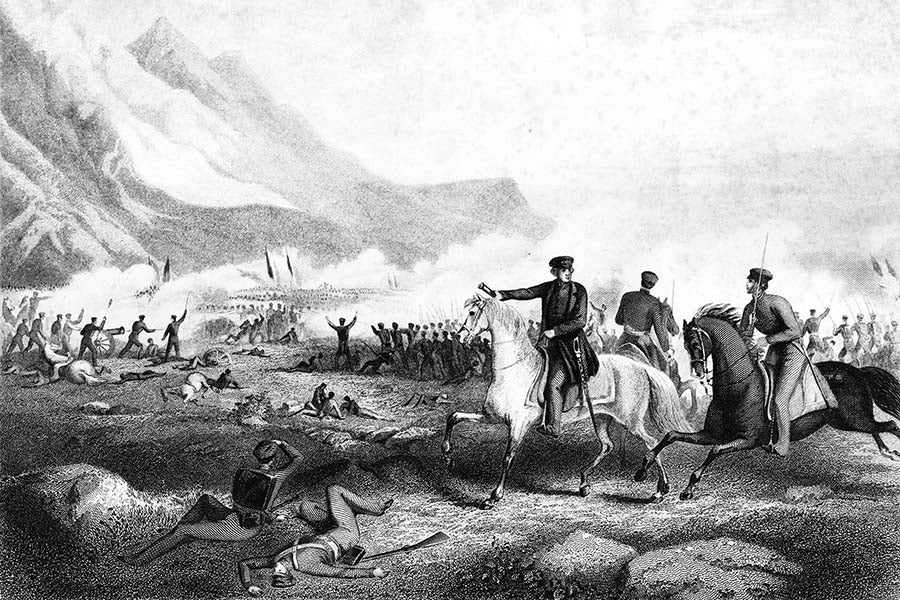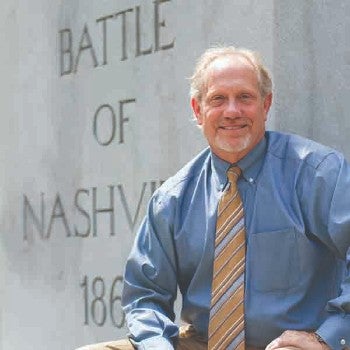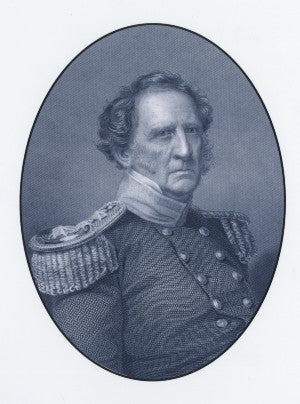Connecting the dots between two wars
Nationally known history scholar explores explores lifelong military careers of Mexican-American War generals in forthcoming, first-of-its kind volume.
Janel Shoun-Smith | 615.966.7078 |

This engraving of the "Battle of Buena Vista," first published in "Lives of the Presidents of the United States of America, From Washington to the Present Time" in 1867," depicts General Zachary Taylor, on white horse, directing his troops during the battle in the Mexican-American War.
See all of Tim Johnson's available books on military history here.
Since his doctoral dissertation back in the 1980s, Tim Johnson has been kicking around a couple of ideas that are changing how historians see the Mexican-American War, one of the least studied conflicts in American history.

His first major research project, a biography of Gen. Winfield Scott, turned into the first of five published books about aspects of the Mexican-American War. He’s been hailed as “one of the top specialists in studying the U.S. Mexican-American War.”
Now, 25 years into his career, he is working on another book that will highlight two concepts he first noticed back at the very start: Scott’s pacification program carried out during the war and the impact the war had on a group of its young officers who went on to become the most famous leaders in the American Civil War.
Johnson, one of Lipscomb’s first designated University Research Professors, who has appeared on The History Channel, on C-SPAN’s BookTV and on public television, is now working on editing his sixth book on the Mexican-American war that will explore both these phenomena that have appeared in his books throughout his career-long research.
Johnson said he has been longing for 20 years to create a book about how the Mexican-American War served as the training ground for Civil War figures such as Ulysses S. Grant, Robert E. Lee and Thomas J. “Stonewall” Jackson.
“More than 200 future Civil War generals served as lower grade officers in Mexico in 1846-47. Their personal experiences as young officers would have certainly informed decision-making 15 years later when they commanded troops in the Civil War,” said Johnson.
To address this question, Johnson reached out to the leading Civil War scholars across the nation with a request to submit chapters. He has now curated the responses into a book with six chapters on Confederate generals, six chapters on Union generals and a forward by Gary Gallagher, renowned Civil War scholar at the University of Virginia.
In addition to curating the chapters submitted by scholars at the U.S. Naval Academy, the University of North Carolina, the University of California at Los Angeles and Arizona State University, to name a few, Johnson is also writing the introduction. In that piece, Johnson notes that one thing Lee and Grant did at the surrender at Appomattox Courthouse was to reminisce about each of their experiences in the Mexican-American War.
Gen. Winfield Scott “.. left law and order in his wake and not pillaging and destruction.” — From Tim Johnson's works on the Mexican-American War general
“This book is the first serious scholarly attempt to connect the dots between these two wars,” said Johnson. “Scholars have produced numerous biographies of prominent Civil War generals, but those biographies generally cover the pre-Civil War years with brevity and treat those years as simply an introduction to the main event.”
One of the themes that Johnson expects to see highlighted in the chapters is how Civil War generals emulated Gen. Scott’s pacification program: his attempt to diffuse any efforts of general uprising among Mexican civilians by treating the population with respect and civility. Scott’s approach to counter-insurgency is a pattern not noted in scholarship before Johnson’s work, he said.
“Scott looked at Napoleon’s invasion of Spain in 1808. The French army entered Spain, pillaging and plundering and murdering, taking whatever they needed, and as a result, the whole Spanish countryside erupted in a guerilla war,” said Johnson. “That completely bogged down the French Army. They had to fight for every crossroad, every bridge, every town, every village, because there was resistance around every corner, because of the way the French had acted as invaders.

Gen. Winfield Scott
“So what did Scott’s Army do? They bought all of their provisions from Mexicans. They purchased what they needed. They paid rent when they used private property to house soldiers. American soldiers were strictly disciplined and punished if they stole a chicken or pig or assaulted a civilian.
“There was guerilla fighting in Mexico, but there was never a pervasive guerilla threat to the American Army,” said Johnson. As he wrote in his first book on Scott: “…he left law and order in his wake and not pillaging and destruction.”
Johnson believes that Scott’s ahead-of-its-time approach to counter-insurgency rubbed off on Gen. Don Carlos Buell and Gen. George McClelland, both of whom used similar pacification techniques during the Civil War. Both of these generals will be the subject of chapters in the forthcoming book.
How to counter civilian insurgency “is an ongoing current issue today in military policy,” said Johnson, referencing the recent war in Ukraine. However, “pacification didn’t seem significant enough to look at prior to Vietnam.”
Today, Johnson hears more scholarly discussion of pacification and has seen Scott’s efforts referenced in a recent military history textbook, he said.
“As a historian, you always hope that you can contribute to new knowledge and that others will take note and adjust the way they teach and the way they write, and the assumptions they make based on what you’ve produced.”